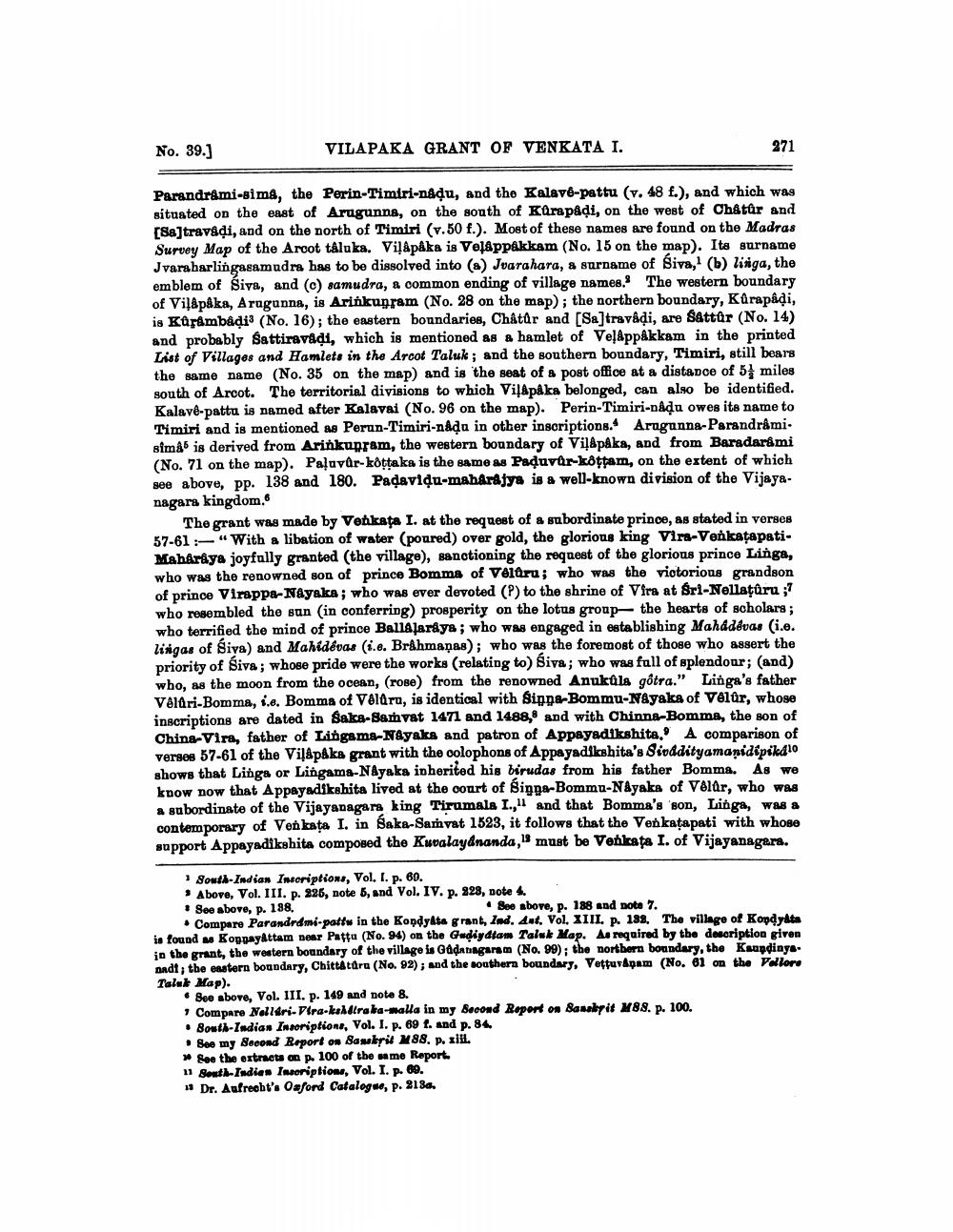________________
No. 39.]
VILAPAKA GRANT OF VENKATA I.
371
Parandrami-sime, the Perin-Timiri-nadu, and the Kalavo-pattu (v. 48 f.), and which was situated on the east of Arugunna, on the south of Kurapadi, on the west of Châtûr and [88]travedi, and on the north of Timiri (v.50 f.). Most of these names are found on the Madras Survey Map of the Arcot taluka. Viļ&påka is Velâppakkam (No. 15 on the map). Its surname Jvaraharlingasamudra has to be dissolved into (a) Juarahara, & surname of Siva, (b) linga, the emblem of Siya, and (c) samudra, a common ending of village names. The western boundary of Vil&påka, Aragunna, is Arinkunram (No. 28 on the map); the northern boundary, Kůrapidi, is Kurambadi (No. 16); the eastern boundaries, Châtår and [Sa]travadi, are Sättür (No. 14) and probably Sattiravidi, which is mentioned as a hamlet of Veļäppåkkam in the printed List of Villages and Hamlets in the Arcot Taluk; and the southern boundary, Timiri, still bears the same name (No. 35 on the map) and is the seat of a post office at a distance of 5} miles south of Arcot. The territorial divisions to which VilApaka belonged, can also be identified. Kalave-patta is named after Kalavai (No. 96 on the map). Perin-Timiri-nadu owes its name to Timiri and is mentioned as Perun-Timiri-nada in other inscriptions. Arnganna-Parandrami. simê is derived from Arinkupram, the western boundary of Viļ&påka, and from Baradarami (No. 71 on the map). Paluvar-kotaka is the same as Paduvar-kottam, on the extent of which see above, pp. 138 and 180. Padavidu-mahardjys is a well-known division of the Vijayanagara kingdom.
The grant was made by Venkata I. at the request of a subordinate prince, as stated in verses 57-61 :-“With a libation of water (poured) over gold, the glorious king Vira-VenkatapatiMaharaya joyfully granted (the village), sanctioning the request of the glorious prince Linga, who was the renowned son of prince Bomma of Velard; who was the victorious grandson of prince Virappa Nayaka; who was ever devoted (P) to the shrine of Vira at Sri-Nellaturu ;? who resembled the sun (in conferring) prosperity on the lotus group- the hearts of scholars; who terrified the mind of prince BallAlaräys; who was engaged in establishing Mahádévas (i.e. lingas of Siva) and Mahidevas (i.e. Bråhmaņas); who was the foremost of those who assert the priority of Siva; whose pride were the works (relating to) Siva; who was full of splendour; (and) who, as the moon from the ocean, (rose) from the renowned Anukuls gôtra." Linga's father Velári-Bomma, i.e. Bomma of Veldra, is identical with Sippa-Bommu-Nayaka of Velúr, whose inscriptions are dated in Saks-Samvat 1471 and 1488, and with Chinna-Bomma, the son of China-Vira, father of Lingama-Nayaks and patron of Appayadikshita. A comparison of verses 57-61 of the Viļ&påks grant with the colophons of Appayadikshita's Sidddityamanidipikalo shows that Linga or Lingama-Ndyaka inherited his birudas from his father Bomma. As we know now that Appayadikshita lived at the court of Bigga-Bomma-Nayaka of Velúr, who was a subordinate of the Vijayanagara king Tirumala I.," and that Bomma's 'son, Linga, was a contemporary of Venkata I. in Baka-Samvat 1523, it follows that the Venkatapati with whose support Appayadikshita composed the Kuvalayananda," must be Venkata I. of Vijayanagara.
South Indian Inscriptions, Vol. I. p. 60. • Above, Vol. III. p. 226, note 5, and Vol. IV. p. 928, note 4 • See above, p. 188.
See above, p. 188 and note 7. . Compare Parandrdmi-patts in the Kondyta grant, Iad. Ant. Vol. XIII. p. 188. The village of Kopdykta is found w Koppayattam near Pattu (No. 94) on the Gudiydtam Taluk Map. As required by the description given in the grant, the western boundary of the village is Gadanagaram (No. 99); the northern boundary, the Kaupdingsnadt, the entorn boundary, Chittaturu (No. 92), and the southern boundary, Vottuvapam (No. 61 on the Vellore Taluk Map).
• See above, Vol. III. p. 149 and note 8.
Compare Ndldri. Pira-kaldiraha-walla in my second Report on Sasabit M88. D. 100. • Bouth-Indias Inscriptions, Vol. I. p. 69 t. and p. 84. • See my second Report on Sanskrit M88. p. ii. * See the extracts on p. 100 of the mme Report 11 South Indian Insoriptions, Vol. I. p. 69. 13 Dr. Aufreobt's Oaford Catalogue, p. 813a.




